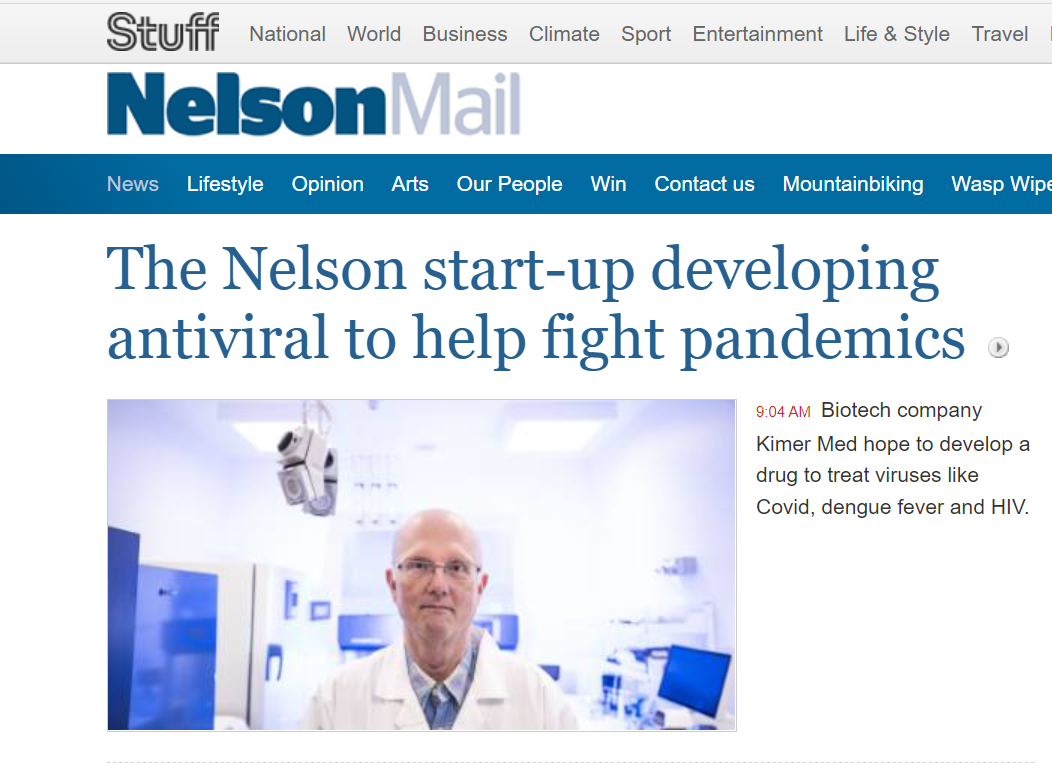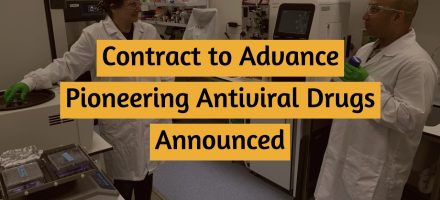Media Release: Nelson, New Zealand – 10 July 2024 – Kimer Med $10M closer to…
Kimer Med responds to comments in media
It was brought to our attention that someone has made a bunch of somewhat pessimistic comments on a Stuff article (November 28) about Kimer Med. We encourage questions about our work, and we don’t mind a healthy dose of scepticism either – but unfortunately in this case the comment section is closed and we have no ability to respond.
Many of the points raised can be easily addressed, with adequate knowledge of the science concerned and the broader context, and we think it’s important to do this. A copy of the comments is included below, and our response to them has been added. A link to the original article can be found at the end of this piece.
We understand that ours is an audacious project, and that it involves both risks and hurdles, but we also think it is too important to fail. There are so many people and animals whose lives can be saved, and so much suffering that can be reduced or eliminated if we are successful. For that reason, it is important that people have all the facts about our antiviral development work.

Comment 1:
From the perspective of media coverage, this approach did attract quite a lot of press when it was first published in 2011 by the original Rider research group at MIT. However, since then virtually nothing was heard, save for an attempt at crowdfunding by the principal researcher Todd Rider in 2015 (which it seems did not attract enough interest). Some articles in the media can be found by googling “Todd Rider antiviral”. For this reason it is interesting that a NZ scientist got government backing up to $150,000 from Callaghan Innovation.
Kimer Med’s response:
This is true. Rider’s DRACO publication was widely hailed as an incredible breakthrough. The story ran in Time magazine, Popular Science, The Boston Globe, The Wall Street Journal, and many other influential publications.
To be clear, we consider the work we’re doing at Kimer Med to be inspired by Dr Rider, but it’s also distinctly our own thing. We received the Callaghan Innovation Project Grant after we had demonstrated the ability to manufacture our compound (VTose) and show its antiviral efficacy. The Project Grant is similar to the R&D tax credit – it is used to support a small fraction of our R&D costs.
Comment 2:
One of the first things that you would want to look at in evaluating a new technology is the production level (i.e., can it actually be manufactured in sufficient quantity to be marketable). If you can’t produce it, you are not going to be able to sell it.
Typically antibody drugs are produced in quantities measured in grams per litre of cell culture. The authors of the original paper (available online at 10.1371/journal.pone.0022572) got typical yields of 30 mg per litre of culture (Figure 1 caption), and looking at the gel photo you can see that the purity of the product was not very high. This means it is difficult to produce and purify from cells.
This suggests that commercial scale production may be problematic.
Kimer Med’s response:
Protein-based drugs are common, and at least 600 have received regulatory (FDA) approval. Yield is sometimes an issue, though certainly not the only one, and for us, not even the first one. The tools and techniques of recombinant protein production have advanced considerably, even in just the last few years. When production issues arise, there are multiple modern and well-documented solutions to employ. Kimer Med already has a number of ideas in this area which we will explore further when the time is right.
As far as selling product is concerned, we do expect the early stage production cost of our compound to be relatively high, but this will fall as we scale up production and refine our process. It’s also important to understand that the cost of medical care, including hospitalisation, for viral diseases is not cheap either. Because of the sheer numbers of cases involved, even a small percentage of these numbers create an enormous market for our antiviral.
Comment 3:
Reading the original paper from MIT, the authors themselves mentioned many areas where optimisation of this technology is needed, including improving cell penetration, production level, pharmacokinetics (serum half life), and the fact that it would not work on chronic viral infections (it kills virus infected cells meaning it would be toxic if too many cells were already infected).
Kimer Med’s response:
This is mostly correct. The path from a discovery paper like Rider’s to a commercial drug normally requires a fair amount of additional work, which is exactly what Kimer Med is currently doing. All these areas of testing are very standard for drug development and discovery.
We actually think that there is a way to make this work on chronic infection as well, which will be of huge interest to some of those neglected communities suffering from the effects of long term, chronic viral infection.
We have been working on fabrication, optimisation, and testing of our antiviral compound for a little over two years now, and continue to make important strides. Throughout this process we have also discovered some new and surprising aspects to it, which have exciting applications in a range of other areas, and we are looking forward to developing these further in due course. Right now though, our focus is getting this drug to the people and animals who need it as fast as we can.
Comment 4:
Curious as to why this company is focusing on DRACO when this was not followed up by the inventors at MIT over 10 years ago, and only one other Chinese group has published a paper on it. You would think that a technology that can treat multiple viral infections would be very valuable if it works. It raises a few questions.
Kimer Med’s response:
Our two co-founders, Phil Oliver and Rick Kiessig, have been following DRACO since 2013 and asking themselves that very same question. That is why they decided to start this company, and answer that question for themselves.
Rider did attempt to follow-up his invention, but had difficulty raising enough funding. We don’t know why he failed in this area, but we do know that Rider was an incredible scientist, and he may not have had the commercial skills needed for such a challenging and expensive project. By contrast, Kimer Med’s CEO, Rick Kiessig, sits in that very sweet spot between science and business. This is the fourteenth start-up he’s founded or worked in, and he has a wealth of high level experience in forming teams, raising money, getting things off the ground, and seeing complex projects through to successful completion. Among Rick’s impressive accomplishments are projects for Lockheed-Martin and NASA, and he has written software that guided a probe mission to a comet and back, and three times to the planet Mars. We think this important mission is in very capable hands.
Comment 5:
A search of the PubMed biomedical literature database using the keywords “DRACO and virus” results in a total of 2 papers on this therapeutic approach (plus one unrelated paper), the original published in 2011, and another one by a Chinese group published in 2015. In comparison, a keyword search for “antibody drug” resulted in 21,000 papers published in 2021 alone.
Kimer Med’s response:
That is interesting, but we are not clear on the point the commenter is trying to make here. Papers about antibodies don’t have anything to do with our compound. What this does show is that there is a lot of research going into monoclonal antibodies (mAbs) – an approach which is seen as a promising way to target cancer and immune diseases.
It may be of interest to note that some viruses, such as HEPC and HPV are known to cause cancer, and many more are linked to a host of chronic disease. Recent studies have exposed the links between viruses and degenerative neurological diseases, such as Alzheimer’s. We are optimistic that our antiviral can be put to good use as a therapeutic in these areas as well.
Comment 6:
Getting a drug from lead discovery past Phase 3 clinical trials in 5 years is unrealistic.
Kimer Med’s response:
Unfortunately, drug discovery and development is a long, complicated and expensive process, so the commentator is not wrong here. However, what was said in the article was “if everything went well, the drug could be ready for market in five to 10 years.” That is actually true.
It may not be widely understood, but the length (and cost) of the clinical trial process depends on a surprisingly wide range of factors. We’ve already been doing R&D for two years now, so we are not at the starting blocks – we’re well underway. One of the key areas of innovation for Kimer Med relates to increasing the speed with which clinical trials can be completed, and regulatory approval received. We have done a lot of work in this area and were in fact recently awarded a Business Innovation award which recognised our unique and innovative approach.
Comment 7:
Plus about 90% of pre-clinical drug candidates fail to reach the market.
Kimer Med’s response:
That is true – but the detail matters. Many of those failures are related to the toxicity that is common with small molecule compounds. Fortunately for Kimer Med, protein-based (large molecule) drug candidates like ours tend to have a much better toxicity profile. This has already been demonstrated in both in vitro (laboratory) and in vivo (in animals) tests.
Comment 8:
I hope the investors have done due diligence. There is another example of a NZ based biotech company that got funded that I know of, and it was painfully obvious that the VC was being taken for a ride.
Kimer Med’s response:
We don’t know who the other company referred to here is, but we support the idea that any and all investors should do their due diligence.
We received our seed funding in March 2021, and numerous third parties who have examined our business and science progress since then believe in both our mission and our ability to execute. Any investment has risks, and most people and VC firms who invest in biotech understand that, by its very nature, it is an inherently risky sector. However, it is not everyday that you get the opportunity to invest in a business that could fundamentally change the world in such a powerful and positive way. When you factor in the extent of the need for effective antivirals, and the size of the market that is represented here, we are confident that Kimer Med will appeal to the right investors when the time comes for us to raise more capital.
Link to the original article which appeared in the Nelson Mail and Stuff:
https://www.stuff.co.nz/national/health/130537292/nelson-startup-developing-antiviral-drug-to-help-fight-future-pandemics


